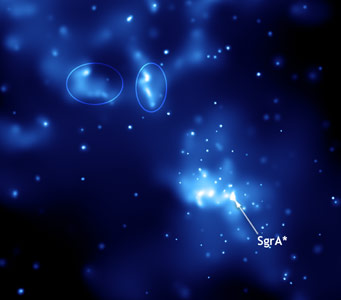
This image shows the clouds of gas that are illuminated from the black hole in the center of the Milky Way. Sagittarius A* is labeled at bottom right. Click on the image to see a 3 MB Quicktime movie of the clouds' evolution.
NASA/CXC/Caltech/M.Muno et al.
The Milky Way has a monster black hole lurking in its core, but it's on a starvation diet. The black hole, known as Sagittarius A*, weighs in at about 4 million solar masses. But despite the beast's overwhelming gravitational pull, recent studies show that it consumes only a pathetic fraction of Earth's mass in a typical year. For some unknown reason, very little food is falling into the black hole, so it remains calm and quiet — radiating very little energy.
Fortunately for the monster, every now and then it enjoys a snack. At last week's American Astronomical Society meeting in Seattle, Michael Muno (Caltech) and his colleagues reported that Sagittarius A* gobbled a chunk of matter about 60 years ago. The event unleashed a pulse of X-rays that radiated outward from the core, illuminating nearby gas clouds. Using NASA's Chandra X-ray Observatory, Muno's group detected X-rays reflecting off two gas clouds several dozen light-years from the black hole. The illumination changed in shape and intensity over a three-year period as the X-rays traveled through the clouds. Such outwardly propagating patterns of light are known as light echoes.
Based on the amount of reflected X-rays, Sagittarius A*'s X-ray brightness increased by about 100,000 during the flare. Armed with theoretical models of how efficiently black holes convert infalling matter to X-rays, Muno estimates that a chunk of material about the mass of Mercury fell into the black hole over the course of one or two years. "This dramatic event happened before we had satellites in space that could detect it," says Muno.
It remains unclear what triggered this event. One possibility is that a rocky body the size of Mercury had the misfortune of roaming into the black hole's gravitational clutches, where it was tidally shredded and its pieces gradually fell into the abyss. Alternatively, the disk of material thought to swirl around Sagittarius A* might have become unstable, sending a stream of material into the black hole.
Whatever the cause, this wasn't the monster's first snack. Muno notes that other patches of bright X-ray emission have been detected much farther from the black hole, suggesting that Sagittarius A* occasionally enjoys a feeding frenzy. "We think the same processes have been happening farther and farther back in time, possibly with greater amplitudes," says Muno.
 0
0
Comments
You must be logged in to post a comment.